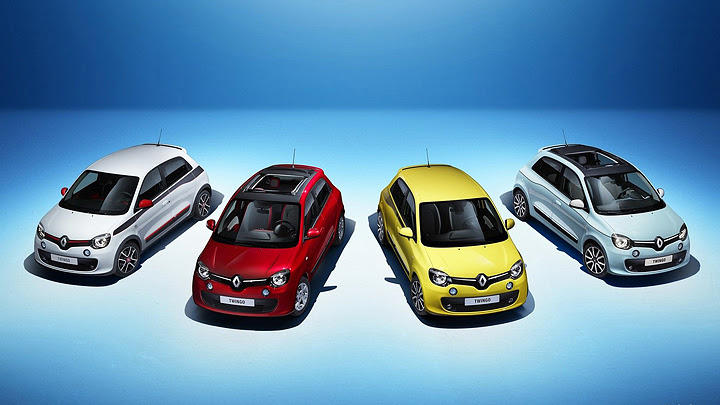 Renault’s “strip-tweet” was a very creative event used to reveal what turns out to be a very interesting vehicle. After months of seeing spy photos, meeting both Twin’Z and Twin’Run concepts and reading facts of various levels of veracity, now the real deal was finally shown. Since its latest strategies seem to have led the French automaker into a very favorable moment, the all-new Twingo arrives as a small-package version of everything that could possibly help Renault to finish associating its own image to the values it began to extol most recently.
Renault’s “strip-tweet” was a very creative event used to reveal what turns out to be a very interesting vehicle. After months of seeing spy photos, meeting both Twin’Z and Twin’Run concepts and reading facts of various levels of veracity, now the real deal was finally shown. Since its latest strategies seem to have led the French automaker into a very favorable moment, the all-new Twingo arrives as a small-package version of everything that could possibly help Renault to finish associating its own image to the values it began to extol most recently.
Since the last decade saw Dacia growing fast enough to become a truly competitive marque, Renault had to start separating itself from the low-cost branch as much as possible. The first step was to leave cars like Dokker and Logan with the Romanian company, while the French retained the upscale models such as Mégane and Laguna, and it wasn’t hard. The real problem in cases like this appears when there are overlaps, but instead of eliminating these lemons, Renault decided to make lemonade. Having Sandero to take care of the rational hatchback clients, Clio was freed to honor its sporty genes more than ever. Duster’s tough looks and simple construction allowed Captur to be a perfect urban crossover… There are several other examples.
When it comes to Twingo, however, the task of setting it apart from Dacia’s image wasn’t so hard because it has a very strong personality of its own. Long before the supermini trend of nowadays, Renault’s supermini arrived in 1992 filled with creative solutions for its time, such as central instrument cluster and sliding rear bench. Not to mention the boxy silhouette, which was the biggest reason why the car became famous. The second generation invested on sporty trims for the first time, but it needed to be replaced quicker because its category was taking a new direction. The renewed Mini Cooper and Fiat 500’s huge success spurred the arrival of competitors such as Citroën DS3 and Opel Adam, so whoever had older cars than these needed to adapt as soon as possible.








But it would be wrong to think Twingo turned into just another one of those. Renault decided to toy with past and present this time, wrapping the car’s typical characteristics into a whole new design inspired on the 5 hatchback, resulting once again on a very original car and, at last, a strong competitor against the aforementioned vehicles. The vintage influences are seen at the traditional rear windshield slant and at preserving the reduced dimensions, but they’re combined to the company’s current design language. The front fascia brings Renault’s logo in a great size, the typical slim grille in black and the circular auxiliary headlights which appeared at the outgoing Twingo. The rear features an all-glass trunk lid, but there’s much more to say about it.
Have you noticed how short both overhangs are? You’ll be grateful to Renault after every short-spaced maneuver you’ll have to perform, but this isn’t their main raison d’être. Twingo’s new silhouette is due to a rear-mounted-engine project, which also uses rear-wheel-drive and was developed with Mercedes-Benz (this platform will also underpin the next smart fortwo and ForFour). Paired to having the wheels as far from the center as possible, such construction is expected to deliver the best handling of its class, for the fans of sporty driving. But while high-performance versions don’t arrive, like R.S. and Gordini, the most obvious advantage of this layout is more room for cabin and trunk. And with five doors, for the first time ever.




Speaking of the interior, the room follows the exterior’s style. The playful shapes alternate black with white and several accents on one of the external colors. The equipment list should achieve the same level of the rivals’, and features a lot of customization options. You’ll certainly be able to choose between several trims in many colors, match each one with a particular wheel design and tweak the result with themed stickers and painting some parts in a secondary color, like mirror caps and front grille accents. These official pictures reveal that Twingo already arrives with a panoramic sunroof, whose cloth top discovers only the roof, unlike Citroën DS3 Cabrio and Fiat 500C’s systems.
Twingo’s urban trims will have two engine options, both gasoline-burners. The naturally-aspirated 1.0L produces 69 hp, while the 0.9L tCe unit (turbocharged and three-cylinder) reaches 89 hp – if you want more power, the sporty variations are highly expected to make great use of the enormous potential given by the vehicle’s new construction. Further information hasn’t been released yet, but the new hatchback is also expected to be faster than the outgoing, and at the same time consuming less fuel and emitting less CO2. Besides, the entry-level version will arrive a little cheaper. The new Renault Twingo will have its first official presentation at the upcoming Geneva Auto Show.